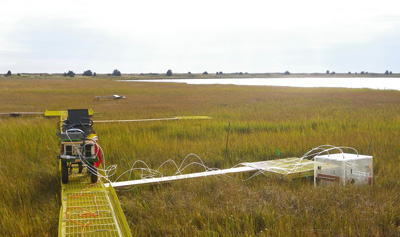Team Explores Salt Marsh Restoration to Offset Global Warming

By Stephanie M. McPherson
Salt marshes have been flooded by inland freshwater along nearly a third of the U.S. Atlantic coast, due to diversions by dams, dikes, and other human constructs. This hurts more than the natural biodiversity of a saltwater system. As salt marshes freshen, they emit more and more methane—a powerful greenhouse gas.
“A molecule of methane is 30 times more potent as a greenhouse gas than a molecule of carbon dioxide,” says Jim Tang, an associate scientist in the MBL Ecosystems Center.
Tang and his colleagues at the Bringing Wetlands to Market (BWM) project are laying out a framework for returning salt marshes to their natural salinity by removing various tidal restrictions. In a recently published study, they modeled the rate of methane emissions from freshened marshes and suggested mitigations to the problem.
 Measuring greenhouse gas fluxes at Waquoit Bay, Falmouth, Mass., using a transparent chamber and a state-of-the-art gas analyzer assembled by the Tang lab at MBL. Credit: Jim Tang
Measuring greenhouse gas fluxes at Waquoit Bay, Falmouth, Mass., using a transparent chamber and a state-of-the-art gas analyzer assembled by the Tang lab at MBL. Credit: Jim TangDepending on the amount of damage in a freshened salt marsh, one hectare of marsh (a little less than two football fields) emits enough methane to cause as much atmospheric warming as 0.6 to 3.1 million cars running their engines continuously. According to Tang and his colleagues’ model, once a hectare of the salt marsh ecosystem is restored, associated atmospheric cooling should begin within five years.
Salty marshes emit much less methane than their freshwater counterparts because of the tiny organisms that inhabit them. The microbes in salt marshes use sulfate ions from ocean water to create energy. But when the ocean water goes away, microbes need to find different energy sources. That switch causes them to create methane as a byproduct, and a lot of it. Restoring the salinity of salt marshes would give back to microbes their original energy source, thus dramatically reducing the amount of methane they emit.
Reducing methane emissions from salt marshes supplements international work to improve the uptake of carbon in coastal environments ("blue carbon"). Tang and his colleagues worked on carbon sequestration in phase 1 of their BWM project; this quantification of methane reduction is phase 2.
“We use modeling studies as the basis for applications that assess the effects of coastal wetland restoration on greenhouse gas emissions and carbon sequestration,” he says. He and his colleagues are currently studying a real-world version of their restoration models at Herring River in Wellfleet, Mass.
Tang hopes that this study will add to the growing list of incentives for companies and governments to repair damaged coastlines and bridge the gap between science and policy. To that end, Tang is also part of a National Academy of Sciences committee to explore various methods of atmospheric greenhouse gas removal including restoring coastal systems, geologic sequestration, direct air capture, and forest capture. Demonstrating that improving natural conditions can reduce methane as well as carbon dioxide emissions is a positive step forward.
“This can be applied to the larger New England area and other coastal areas of the world,” Tang says.